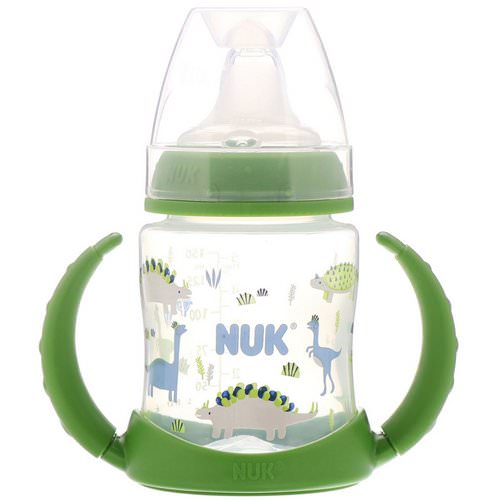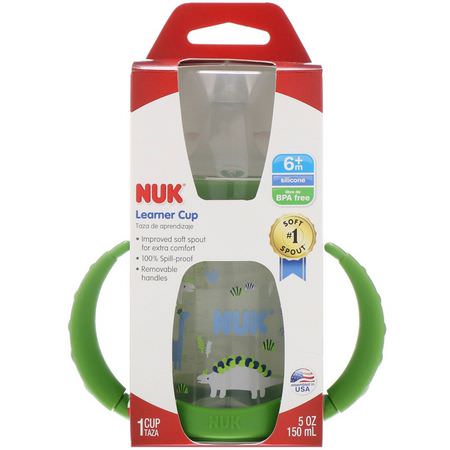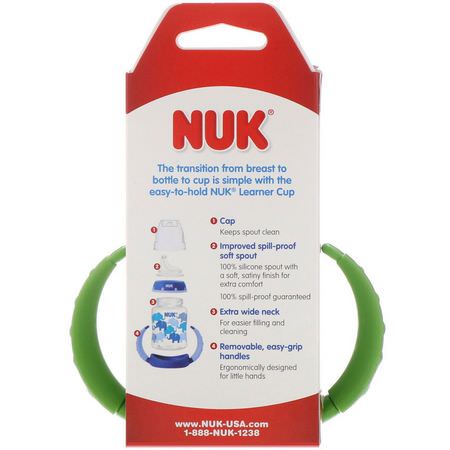Foodpharmacy Blog: Kids, Baby, Kids Feeding, Cups
NUK, Learner Cup, 6+ Months, Dinosaur, 1 Cup, 5 oz (150 ml)

$5.20
Product name: NUK, Learner Cup, 6+ Months, Dinosaur, 1 Cup, 5 oz (150 ml)
Quantity: 1 Count, 0.11 kg, 16.3 x 11.4 x 7.4 cm
Categories: NUK, Baby, Kids, Kids Feeding, Cups, Bpa Free
Satiny Finish for More Comfort, 6+ Months, Silicone, BPA Free, #1 Soft Spout, Improved Soft Spout for Extra Comfort, 100% Spill Proof, Removable Handles, The transition from breast to bottle to cup is simple with the easy-to-hold NUK Learner Cup, Cap -Keeps spout clean, Improved Spill-Proof Soft Spout- 100% silicone spout with a soft, satiny finish for extra comfort.100% spill-proof guaranteed, Extra Wide Neck -For easier filling and cleaning, Removable, Easy-Grip Handles- Ergonomically designed for little hands, NUK – For 60 years, moms have trusted NUK products to help them nurture their babies best, NUK Transition Cups, NUK has a full line of cups to ease baby’s transition from bottle-to-cup, Learner Cup (6 Months+), Large Learner Cup (9 Months+), Active Cup (12 Months+), Hard Sprout Active Cup (12 Months+), Magic 360 Cup (12 Months+), Also Try: NUK Orthodonic Pacifiers, Soothes and calms baby better, Truly orthodonic shape naturally fits baby’s mouth, Based on Market Research, June 2013, tested with 110 NUK pacifier users.

This is where the tommee tippee has great advantage of, it is light compared to other sippy cups, as the bottle has a 5 oz. They help to distribute nutrients to your cells and also aid your kidneys in removing waste from your blood stream. And although yasmin has not made use of it yet, the thinkster base also fits the thinkbaby no-spill spout for toddlers, so you do not have to buy a new bottle when your child transitions to a more advanced cup. The cups are made from plastic and are bpa-free. Then the parents will spend even more for each stage their child goes through. That is why it is advisable to fill sippy cups with water if you intend to have your kid use it for the whole day. Yes, if your baby is not yet ready for the spout, let him hold the sippy cup and use the nipple to get him accustomed to it. They are slightly larger than the last cups, and they only feature one design: A penguin carrying three brightly-colored balloons. If you want a slightly larger cup for your young one, i recommend buying these cups over the other ones. A couple can even be set aside for when you want to go out with your baby.
NUK, Learner Cup, 6+ Months, Dinosaur, 1 Cup, 5 oz (150 ml): Cups, Kids Feeding, Kids, Baby
The cup not only has an easy to open spout for the child to learn to drink normally from, but the opening is made to be spill proof, so you do not have to worry about a lot of cleaning up. In all seriousness, these are not the best sippy cups on the market. Many mothers wonder when to transition their baby from breastfeeding to a sippy cup. Generally, only go for sippy cups without handles if your child is above 12 months. She explains that children use an immature, infant-like sucking motion when drinking from a sippy cup, and the spout prevents the front of the tongue from elevating during swallowing. These trainer cups hold up to 5 ounces of liquid. And despite the difference in size and decals, there is essentially no difference in the sippy cups. Actually you would not want a sippy that your baby has to suck on with all their might.

That being said, some of these sippy cups did way better in the dishwasher than others. That is why it is important to purchase sippy cups that are relatively easy to dismantle. Below are the features of cups which have been sorted according to age or developmental milestone. The bite resistant spout keeps kids from ruining the cup, and the seal zone technology provides a 100 percent leak-proof, spill-proof, break-proof experience. These cups have to be tipped back, just like a bottle. Make sure to separate your baby from her drinking source and brush those teeth well before bed! The soft spout will also be an easier transition for your child who is weaning off of a bottle, while promoting the proper sucking technique for older children. A new baby is a new life added to your family and as a mom you only want the best for your little one. Your baby must develop her oral motor control to learn how to seal her lips on the side of an open cup, receive some water, keep that seal while swallowing and move the cup away from her mouth.
They are 100% plastic free which means that there is not only no risk of bpa and phthalate exposure to the baby but also no risk of contamination with any other agents present in plastic that may still be unknown to be harmful. Your baby is still trying to establish proper coordination; along the lines of starting to walk, and firming their grips, they are inching closer to causing mayhem in your household. If you want to avoid potential speech or dental problems caused by sippy cups, the straw is a great option. Straw cups offer less practice for these skills because your baby can successfully drink from them while still reclining and sucking, and not sitting upright or fully tipping the cup to her mouth. However, the silicone is very soft and it can be damaged by children who have teeth and are likely to chew. A first stage sippy cup will come with a soft spout for drinking, which gives the child the feel of a bottle or nipple, while still inducing them to make a sucking motion to drink. As you would expect, these cups are bpa-free and perfectly safe to use in the dishwasher. If you are opting for a sippy cup with a straw, make sure it has an open and close feature to protect the straw and keep it clean when your baby is not using it. Despite all of this, the spout is still easy for kids to drink out of. Kids love bright colors and would easily reach out for these cups. The lid will automatically seal when your child stops drinking.
Still, now that there are many sippy cups that are completely plastic free, i am reluctant to call this one the good stuff. Once you introduce this cups to them they will learn to drink from a cup leaving behind the feeders, not only this with this sippy cups you can keep your child clean and dry for long time. Moreover, first years has matching utensils and plates which have similar film designs as the sippy cups for a coordinating feeding. Pura has got a lot of good press for the recyclable, plastic-free design, and we do like that you can keep milk cold in this bottle for much longer than any of the other cups. Any of the sippy cups reviewed above would be perfect for your kid. Tip the cup upwards slightly to make the milk flow into his mouth, and then slowly leave your grip to let your baby drink on his own. You can start using these cups with kids as young as 6 months old, but they are more suited for toddlers who are ready to train for an open cup. While these cups have various names such as transition cups, trainer cups, or sippy cups, they all general mean the same thing.
NUK Cups
Drinking exclusively from a bottle or hard-spouted sippy cup might delay this feeding development. I know that we need products that are safe and reliable for our children, but we also need them to be easy to clean and maintain. If you decide to purchase a glass bottle that has a painted logo or volume markers on it, you might consider using an at home lead test to test it before giving it to your child. Otherwise, many young children have loved this cup and it became the only sippy cup some would use during their transition. I, myself, have purchased multiple sippy cups trying to find the perfect one for my now 15-month-old. The changing from bottle to cup stage could be a little messy, not just because of spills or leaks, but on how your child would adapt to the development they are about to go through. The handles are interchangeable and when your child moves up to the 10 ounce 360 sippy cup, the handles can move with the cup, or stay behind with the smaller trainer cup. In the infant stage, the bottle is squeezable so you can assist with feeding. These are the most bottle-like cups we tested, with soft spouts that might appeal to some youngsters who refuse to wean with the hard spout on a conventional sippy cup. Second, if your kid gets formula or milk in a bottle during the day, he may not want to eat solid food at mealtimes. This prevents the child from snacking too much or comfort feeding.
When we transitioned our baby from bottle to cup, we started with a straw cup. With one of my no spill cups, it took me a couple weeks to realize that the one piece on the top actually. The handles can be removed as your child gets more skilled at holding a cup. With some of the products we recommend (For example, the duralex tumblers or the elk and friends cups), it will be fairly easy to spot any breakage. This could lead to baby ingesting small pieces of glass. I sort of dread that time, just because sippy cups are notoriously so hard to wash. These are the classic sippy cups made for babies and toddlers of individual age groups. The munchkin miracle 360 cups are more similar to open cups than bottles. One note of caution: This type of cup functioning may take some kids a little longer to learn, but kids who do make the transition have an easy time switching to drinking to open cups.
This is when sippy cups tend to become part of the equation. With these cups one can drink like a normal cup as after removing the rim it becomes like a cup. There are no hard and fast rules about what to expect from kids when you try to introduce sippy cups into their daily routine. After using a bunch of different sippy cups on my own son and talking to a top pediatrician about what to look for, these are the best sippy cups i have found. There are sippy cups that have handles and sippy cups that have indents. Infants below 7 months should use sippy cups with handles because their hands are too small to hold and lift the cups. Make sure to never reassemble cups until all components are completely dry, and set them on a drying rack rather than a towel to allow for maximum airflow. The collection comes with an array of colors, which allows parents and kids he option of matching the lid to the same color of the cup, or changing it around if they so like. There are various cups to select from, one must select a trainer cup at initial ages and later must switch to 360 cup so that a child could learn to drink from normal mug soon. If baby has started solids, mix the solids with lots of breastmilk. These sippy cups are made from fda approved recycled milk jugs. Which sippy cup is best for a breastfed baby? These sippy cups hold up to 9 ounces of liquid.
Additionally, the cup has an air vent that stops your baby from swallowing air.